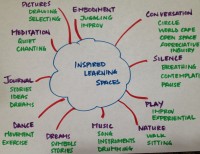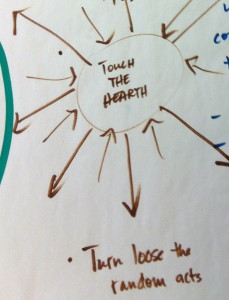Inspiring Learning Spaces
In the early 2000s Toke Moeller and I talked about these. We named some of what it takes to create good learning together. Since then, I’ve given much thought and practice to developing a wider view of inspired learning spaces. What I love about it is that it looks beyond conversational leadership. Often, from the lineage of The Art of Hosting, there is much focus on conversation as premier modality. This is important. It is one of the ways that we humans connect with each other. It is a direct challenge to command and control systems that tend to offer more mandates and dictates, more marching orders than invitations to explore.
As important as the conversations are, and the modalities that support this, I have always felt that there is more that we must attend too. What are the other ways that we find connection with each other? What are other modalities that help a group over time? What is important to help better weave different learning styles or personality types into the room? For me it is important to name that I’m not looking for a bag of party tricks here. When I use any of the activities in this photo, I’m not looking for ice-breakers that are cute to start a meeting. I’m looking for other modalities that help the people in the room connect more with each other and connect more with the multiple layers of purpose that are present among them.
Touch the Hearth
Cathy Remus is one of my favorite colleagues and people. When I met Cathy in 2008, her professional life was as a labour educator for CUPE, The Canadian Union of Public Employees. Myself and two other colleagues hosted a training, staff retreat, and planning session for a group of 30 national labour educators. The short of it is that this process went well. Cathy and her colleagues at CUPE took what they had learned from the experience and spread it across many parts of the labour movement in Canada. In speaking with Cathy in early 2014, I was impressed with the way she continued to speak about needing to come back to the source. Come back to the place where it began.
I tend to call this touching the hearth. It is a model for scaling. Come together. Learn. Strengthen relationships. Do work together. And then go do that work. Not all will move together on all projects. Some will even fall by the way side. This happens if we commit to self-organization and will test many of us on our ability to refrain from digressing to models of control and coercion. However, some will stick. The key is to do the work, then gather again. Touch the hearth again. The source that comes from a group of people huddling together to explore the unknown, ask for the help that they need, and recommit to purpose.
When I think of touching the hearth, I think of coming to a fire. To get warm. To talk. To have some food. There is an energy created in being together. It is relationship centered, but it is not just about relationships. It is as Teresa Posakony so often said, “I don’t know, but we do.” It is as if there is an entity of the whole group that is different that the sum of the people that have gathered together. That is a hearth that offers regeneration, essential in the complex times that we live in.


